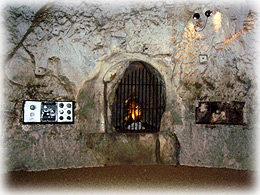Eleanor Cobham, Duchess of Gloucester
Immortalised by Shakespeare, Eleanor Cobham, Duchess of Gloucester was accused of trying to assassinate King Henry VI using witchcraft; a crime for which she received life imprisonment and perhaps left a ghostly legacy.
Eleanor Cobham was the ambitious second wife (married 1428) of Duke Humphrey Plantagenet of Gloucester (1390-1447). Eleanor had been the lady in waiting for Humphrey’s first wife Jacqueline of Holland, and it is suspected they had a relationship together before his first wife passed away. Eleanor bore Humphrey two children: Arthur and Antigone.
Humphrey was Lord Protector of England whilst his nephew Henry VI was still in his minority. When Humphrey’ older brother, John Duke of Bedford (who had been regent in France), died in 1435 Humphrey found himself not only ruling the country, but also next in line to the crown should anything befall his nephew before he produced any heirs.
Though Humphrey was popular he had enemies, amongst whom was Henry Beaufort, Cardinal of Winchester, and the great uncle of Henry VI. It is Beaufort who brought the charges of witchcraft against the Duchess of Gloucester, in all probability within the context of political manoeuvring and power struggle.
The Duchess of Gloucester, an astrologer named Roger Bolingbroke, the Witch of Eye (Margery Jourdemayne), a priest named John Hume and Thomas Southwel the Canon of St Stephens, were all accused of meeting in secret to perform the black arts with the aid of a wax image of the King, which they used with sympathetic magic in order to cause the death of their King.
Apparently John Hume lost his nerve and informed on the secret group, some of whom were promptly arrested. On 25 July 1441, Roger Bolingbroke admitted his part in the plot whilst on a scaffold in front of St Paul’s before the Arch Bishop of Canterbury and the Cardinal of Winchester amongst other notables.
Eleanor who had been named as an accessory in the plot fled to Westminster seeking sanctuary but evidence provided by Bolingbroke resulted in her arrest. She was confined in Leeds Castle, Kent, until her trial date which was set for October.
The group were found guilty: Margery Jourdemayne was burned to death at Smithfield as witch and heretic, Thomas Southwel died whilst serving a prison sentence, Roger Bolingbroke was hanged, drawn and quartered on 18 November 1441 at Tyburn, and Eleanor Cobham, Duchess of Gloucester did public penance at three places in the city (paraded in a sheet and carrying a lit taper). She was divorced from her husband and given a life sentence. She spent her remaining fourteen years locked away in the crypt under the chancel of the cathedral at Peel Castle, Isle of Man under the custody of Sir Thomas Stanley. Eleanor was not a content prisoner (is there such a thing? Ed.), she was kept under constant guard to prevent her escape or suicide.
The duchess is referred to by Shakespeare in his play of Henry VI. part ii act ii. scene 3:
King Henry Stand forth dame Eleanor Cobham,
Glouster’s wife.
In sight of God and us, your guilt is great:
Receive the sentence of the law, for sins
Such as by God’s book are adjudged to death.
You, madam, for you are more nobly born,
Despoiled of your honour in your life,
Shall, after three days’ open penance done,
Live in your country here, in banishment,
With Sir John Stanley, in the Isle of Man.
Leeds Castle is haunted by a large Black Dog that has been attributed to the Duchess of Gloucester. Peel Castle is also haunted by a large Black Dog, coincidence, or perhaps part of the same tradition. Was Eleanor Cobham a party to the use of Black Arts in an assassination attempt to gain her husband the throne of England and make herself Queen or, was she a pawn in a political game to discredit her husband? There can be little doubt that torture was used to gain confessions, especially when sorcery and witchcraft were seen as such a heinous crime.





Recent Comments